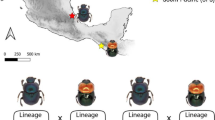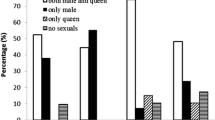Abstract
Bactrocera neohumeralis and Bactrocera tryoni are closely related tephritid fruit fly species. B. neohumeralis mates throughout the day (in bright light) and B. tryoni mates at dusk. The two species can also be distinguished by the colour of their calli (prothoracic sclerites) which are brown and yellow, respectively. The F1 hybrids can mate both in bright light just before dusk and during dusk and have calli that are partly brown and partly yellow. The F2 hybrids have a wider range of callus patterns and mating occurs more widely in the day as well as at dusk. We directly selected hybrid stocks for mating time, creating ‘early’ (day-mating) and ‘late’ (dusk-mating) lines. As an apparently inadvertent consequence, the two types of line respectively had predominantly brown and predominantly yellow calli and thus came to closely resemble the original two species in both behaviour and appearance. Lines that were evenly selected (half for day and half for dusk) essentially retained the mating pattern of F2 hybrids. Selection for callus colour alone also affected the distribution of mating times in a predictable way. We propose a genetical model to account for the results and discuss them in the light of the apparent maintenance of species integrity in nature.
Similar content being viewed by others
References
An, X., K. Wilkes, Y. Bastian, J.L. Morrow, M. Frommer & K.A. Raphael, 2002. The period gene in two species of tephritid fruit fly differentiated by mating behaviour Insect Mol. Biol. 11: 419–430.
Barton Browne, L., 1957. The effect of light on the mating behaviour of the Queensland fruit fly Strumeta tryoni (Frogg.). Aust. J. Zool. 5: 145–158.
Bateman, M.A., 1967. Adaptations to temperature in geographic races of the Queensland fruit fly, Dacus (Strumeta) tryoni. Aust. J. Zool. 15: 1141–1161.
Birch, L.C., 1961. Natural selection between two species of tephritid fruit fly of the genus Dacus. Evolution 15: 360–374.
Birch, L.C. & W.G. Vogt, 1970. Plasticity of taxonomic characters of the Queensland fruit flies Dacus tryoni and Dacus neohumeralis (Tephritidae). Evolution 24: 320–343.
Drew, R.A.I., 1978. Section I. Taxonomy, pp. 1–94 in Economic Fruit Flies of the South Pacific Region, edited by R.A.I. Drew, G.H.S. Hooper & M.A. Bateman Queensland Department of Primary Industries, Brisbane.
Drew, R.A.I., 1989. The tropical fruit flies (Diptera: Tephritidae; Dacinae) of the Australasian and Oceanian regions. Memoirs of the Queensland Museum 26: 1–521.
Gasser, M., M. Kaiser, D. Berrigan & S.C. Stearns, 2000. Lifehistory correlates of evolution under high and low adult mortality. Evolution 54: 1260–1272.
Gee, J.H., 1969. Effect of daily synchronisation of sexual activity and mating success in laboratory populations of two species of Dacus (Diptera: Tephritidae). Aust. J. Zool. 17: 619–624.
Gibbs, G.W., 1968. The frequency of interbreeding between two sibling species of Dacus (Diptera) in wild populations. Evolution 22: 667–683.
Malmkvist, J., B. Houbak & S.W. Hansen, 1997. Mating time and litter size in farm milk selected for confident or timid behaviour. Anim Sci 65: 521–525.
Miyatake, T., 1997a. Genetic trade-off between early fecundity and longevity in Bactrocera cucurbitae (Diptera: Tephritidae). Heredity 78: 93–100.
Miyatake, T., 1997b. Correlated responses to selection for developmental period in Bactrocera cucurbitae (Diptera: Tephritidae): time of mating and daily activity rhythms. Behav. Genet. 27: 489–498.
Miyatake, T., 1998. Genetic changes of life history and behavioral traits during mass-rearing in the melon fly, Bactrocera cucurbitae (Diptera: Tephritidae). Res. Popul. Ecol. 40: 301–310.
Miyatake, T. & T. Shimizu, 1999. Genetic correlations between lifehistory and behavioral traits can cause reproductive isolation. Evolution 53: 201–208.
Miyatake, T., A. Matsumoto, T. Matsuyama, H.R. Ueda, T. Toyosato & T. Tanimura, 2002. The period gene and allochronic reproductive isolation in Bactrocera cucurbitae. R. Soc. Proc. B 269: 2467–2472.
Morrow, J., L. Scott, B. Congdon, D. Yeates, M. Frommer & J. Sved, 2000. Close genetic similarity between two sympatric species of tephritid fruit fly reproductively isolated by mating time. Evolution 54: 899–910.
Osborne, R., A. Meats, M. Frommer, J.A. Sved, R.A.I. Drew & M.K. Robson, 1997. Australian distribution of 17 species of fruit flies (Diptera: Tephritidae) caught in cue lure traps in February 1994. Aust. J. Entomol. 36: 45–50.
Pike, N. & A. Meats, 2002. Potential for mating between Bactrocera tryoni (Froggatt) and B. neohumeralis (Hardy) (Diptera: Tephritidae). Aust. J. Entomol. 41: 70–74.
Pike, N.,W.Y.S. Wang & A. Meats, 2003. The likely fate of hybrids of Bactrocera tryoni and Bactrocera neohumeralis. Heredity (in press).
Rohlf, F.J. & R.R. Sokal, 1981. Statistical Tables, Freeman, San Francisco, 2nd edn.
Shimizu, T., T. Miyatake, Y. Watari & T. Arai, 1997. A gene pleiotropically controlling developmental and circadian periods in the melon fly, Bactrocera cucurbitae (Diptera: Tephritidae). Heredity 79: 600–605.
Smith, P.H., 1979. Genetic manipulation of the circadian clock's timing of sexual behaviour in the Queensland fruit flies, Dacus tryoni and Dacus neohumeralis. Physiol. Entomol. 4: 71–78.
Snedecor, G.W. & W.G. Cochran, 1980. Statistical Methods, Iowa State University Press, Iowa.
Tychsen, P.H., 1977. Mating behaviour of the Queensland fruit fly, Dacus tryoni (Diptera: Tephritidae), in field cages. J. Aust. Entomol. Soc. 16: 459–465.
Tychsen, P.H. & B.S. Fletcher, 1971. Studies on the rhythm of mating in the Queensland fruit fly, Dacus tryoni. J. Insect Physiol. 17: 2139–2156.
Vogt, W.G., 1977. A re-evaluation of introgression between Dacus tryoni and Dacus neohumeralis (Diptera: Tephritidae). Aust. J. Zool. 25: 59–69.
Wolda, H., 1967. Reproductive isolation between two closely related species of the Queensland fruit fly, Dacus tryoni (Frogg.) and D. neohumeralis Hardy (Diptera: Tephritidae). II. Genetic variation in humeral callus pattern in each species as compared with laboratory-bred hybrids. Aust. J. Zool. 15: 515–539.
Zhao, J.T., M. Frommer, J.A. Sved & A. Zacharopoulou, 1998. Mitotic and polythene chromosome analyses in the Queensland fruit fly, Bactrocera tryoni. Genome 41: 510–526.
Author information
Authors and Affiliations
Rights and permissions
About this article
Cite this article
Meats, A., Pike, N., An, X. et al. The Effects of Selection for early (day) and late (dusk) Mating lines of Hybrids of Bactrocera tryoni and Bactrocera neohumeralis . Genetica 119, 283–293 (2003). https://doi.org/10.1023/B:GENE.0000003683.42395.51
Issue Date:
DOI: https://doi.org/10.1023/B:GENE.0000003683.42395.51




